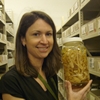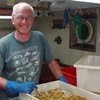Other Names
- Sand-borer
- Sponge Shrimp
General Description
Rostrum trilobed, medial lobe with up to 10 tubercles each side; lateral lobes half as long as medial lobe, separated by broad U. Fourth segment (merus) of first leg (pereopod 1) spinose on lower edge; distal margin of fifth segment (carpus) with strong lower spine, shorter upper spines; sixth segment (propodus) with denticles on lower margin and small upper spine distally; fixed finger one-fifth length of last segment (dactylus). Tail fan (telson) wider than long, smooth, margin concave. Carapace up to 4 cm long.
Biology
Very little is known of the biology of this family of animals but they are thought to be sediment feeders. They can only be found by destroying their habitats so are rarely seen.
Habitat
Intertidal to high subtidal, to depth of 9 m.
Soft substrates
Coastal shores
Distribution guide
Southern temperate oceans, including eastern Australia.
Species Group
Prawns, shrimps, lobsters › Ghost and mud shrimps
Depth
Shore (0-1 m)
Shallow (1-30 m)
Water Column
Max Size
4 cm
Diet
Organic matter
Harmful
Small claws but unlikely to nip.
Commercial Species
No
Global Dispersal
Native to Australia
Species Code
MoV 1757
Conservation Status
- DSE Advisory List : Not listed
- EPBC Act 1999 : Not listed
- IUCN Red List : Not listed









